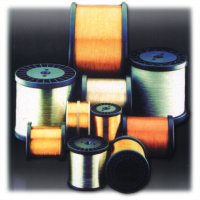|
The evolution (really, a revolution) in wire EDM technology has made it the method of choice for much of today’s critical, high-tolerance applications, including manufacturing production.
Any metalworking tool, including EDM wire, must have the proper combination of characteristics for it to be a viable, cost-effective machining solution. Basically, EDM wire must have the proper electrical, mechanical, geometric, and thermal-physical characteristics or properties to be effective. Electrical Properties Modern EDM (electrical discharge machining) generators impose severe requirements on the wire. One of these is the ability to handle large machining currents that easily exceed 700 peak amps or an average current of 45 amps. This energy transfer must be done efficiently to deliver the high frequency, low current required for surface finishes of 0.2 Ra (8 Rms) or less. This is often expressed as the electrical resistance or conductivity of the wire. Copper wire has one of the highest conductivities, so it is used as a benchmark to measure other materials. Copper is rated at 100% IACS (International Annealed Copper Standard). By comparison, aluminum is rated at 63%, molybdenum is 32%, zinc is 28%, 63/37 brass is 20%, and lead is 8%. Although copper is such a good electrical (and heat) conductor, its choice for wire EDM applications requires consideration of other characteristics to achieve the desired results. Mechanical Properties Tensile strength is a measure of a material’s ability to resist breaking when placed under a longitudinal load. Although tensile strength is usually rated in psi (that is, pounds per square inch of cross-sectional area), wire EDM operators usually talk about tension in terms of so many grams. Copper ranks as one of the lowest (35,000 psi), and molybdenum one of the highest (280,000 psi), strictly in these terms. Moly wire would probably be a fine choice from this point of view; however, it suffers when other desirable properties are considered. Wire gets its tensile strength through material selection; that is, a molybdenum or copper core, or in the case of brass wire (“soft” 70,000 psi, “hard” 130,00 psi, and 2% aluminum alloy 173,000 psi), through the combination of specific alloys and various heat treatment and wire drawing operations. Wires are sometimes referred to as “soft” and “hard.” Either way, each has its preferred use depending on the machine being used and the specific application. Memory is the term applied to describe a wire’s characteristic of being “soft” or “hard.” A soft wire has no “memory;” that is, it is supposed to stay straight when it comes off the spool. While this is not critical while cutting (because of the tension applied to the wire), it is important when trying to thread it automatically during its relaxed state. However, a soft wire is beneficial when doing taper cuts in excess of 7° on machines with non-tilting upper and lower guides. A “hard” wire is ideally suited for automatic threading machines (usually waterjet, for example). Because of its inherently higher tensile strength, it has the ability to resist deflection under cutting forces (electrical and flushing). When specifying wire on non-standard spool sizes, it is important to remember that a “hard” wire can easily take on a set or curvature if wound on too small of a spool diameter.
During the early days of wire EDM (the mid-1970s), copper wire from the electrical motor and cable industry was nearly the only choice. Today, high-performance, high-precision machines require wire with ultra close-tolerance geometric properties. Diamond drawing dies are used in the last manufacturing stages to produce smooth, perfectly round wires with tolerances of ±0.000040" (0.001 mm). A wire’s thermal physical properties are very important. These are determined by the mix of alloying elements (in the case of plain brass and coated wires) or the base core material (that is, for molybdenum wire). The wire’s melting temperature is an important consideration. One desirable feature is to have the wire wear somewhat to promote an open gap at the front of the EDM slot (to prevent/reduce short circuits). In addition, this wear opens a gap at the rear of the slot to improve flushing and remove unwanted debris. Since the wire material is continually being renewed, electrode wear is not a big concern. A lot of heat can be generated in the cut. Some of this heat is lost or soaked up by the wire, which reduces cutting performance. If too much heat is lost to the wire’s core, the wire suffers heat stress and breaks. The wire must be able to vaporize quickly, releasing the energy into the workpiece. All materials possess a melting point and create vapor pressure when heated. One of the desirable qualities of an EDM wire is a low melting point and high vapor pressure, which helps expel contaminants from the gap. Another performance attribute commonly called “good flushability” is when the wire (and the workpiece) vaporizes instead of melts, creating gases instead of particles of molten metal in the cutting zone. This in turn enhances flushing, since there are fewer particles to flush away. A material with a low melting temperature will be easier to vaporize. Cost Justification Finally, the bottom line is profit enhancement. That is exactly the benefit of using the right tool at the right time. It is an accepted practice in the metalworking industry that the intelligent use of carbide tools vs. high-speed steel tools, ceramic vs. carbide, etc., will result in greater productivity and profitability. The same is true of EDM wire, which is often seen as just another necessary consumable item where price is the determining factor in its selection. Consider these costs in today’s EDM business. The capital cost of equipment required to meet higher demands for quality and JIT (just-in-time) delivery. Skilled operators are needed to work as much as three shifts, with overtime and benefits, which puts added pressure on a shop’s ability to be competitive. Competitiveness is often expressed by a shop’s hourly rate to its customers; and profit is directly related to the ability to maximize productivity and minimize costs. The largest, best-run EDM shops have shown that it is possible to invest in better-quality tools and still make money. Ultimately, what works for a particular EDM shop is determined by:
Wire Types – Pluses And Minuses
Charmilles Technologies Corporation - September 2000 |
 Advances in wire technology have kept pace, and more often led, improvements in machine design. However, wire technology is often overlooked as one of the more important contributors to the successful application of this technology. The higher level of performance is the result of several important factors working together, including:
Advances in wire technology have kept pace, and more often led, improvements in machine design. However, wire technology is often overlooked as one of the more important contributors to the successful application of this technology. The higher level of performance is the result of several important factors working together, including: Elongation is expressed as a percentage of length change due to tension forces and thermal forces (heat) during EDM. A soft wire might experience more than 20% elongation, while a hard wire might stretch less than 2%. This becomes important when considering that the wire with the higher elongation will more correctly follow the intended path. In addition, softer wire will introduce fewer vibrations into the cut as it travels over the entry/exit points of the guides. There is a tradeoff, however, in terms of deflection once the wire is in the machining area.
Elongation is expressed as a percentage of length change due to tension forces and thermal forces (heat) during EDM. A soft wire might experience more than 20% elongation, while a hard wire might stretch less than 2%. This becomes important when considering that the wire with the higher elongation will more correctly follow the intended path. In addition, softer wire will introduce fewer vibrations into the cut as it travels over the entry/exit points of the guides. There is a tradeoff, however, in terms of deflection once the wire is in the machining area.